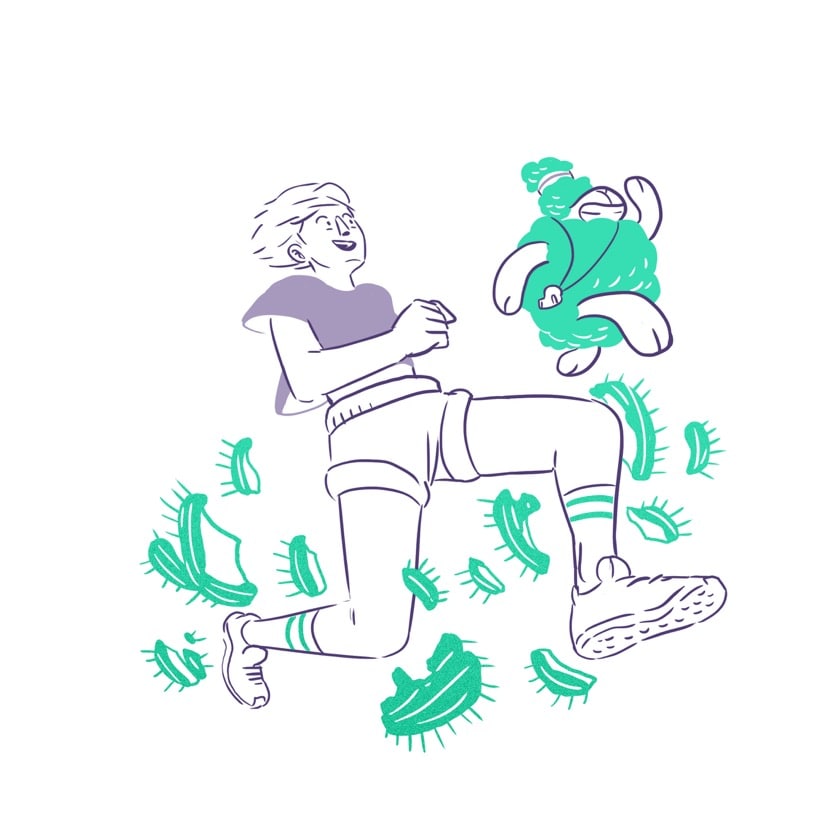Restless legs syndrome: an irrepressible restlessness that tramples sleep
Like a restlessness in the night, movements in broad daylight, jerks in the legs during a moment we would like to be calm and restful. Thus, the restless legs syndrome imposes itself on those who suffer from it: a lack of tranquility caused by a loss of control over one's lower limbs, accompanied by unpleasant sensations in them. What could possibly happen for such a phenomenon to disturb this part of our body?
Legs that do not rest, we prefer when this happens in other circumstances, such as taking a nice walk in nature, or keeping the beat with our feet while listening to music we love, well-paced.
Here, there is obviously no pleasure or interest. This neurological disorder can be likened to a sleep disorder, as it can disrupt the nights of certain people and alter the quality of sleep. What do we know exactly about restless legs syndrome? What are the causes of these restlessness in the legs? We have looked into this thorny subject, so don't run away, and discover everything you need to know about RLS!
What is called restless legs syndrome?
Restless legs syndrome ("SJSR"), also called Willis and Ekbom disease, is a chronic disorder characterized by an irresistible need to move one's legs, to shake them, while experiencing sensations like tingling, a kind of prickling in them. These highly unpleasant sensations, sometimes even resembling burns on the skin, leave little respite for those who endure them. SJSR manifests, moreover, during moments... of rest! And that is the problem: attention is focused on these disturbing sensations and the resulting leg movements. Moments of calm thus turn into torment, whether at night, when trying to sleep, or when sitting (at the office, at home, or worse, in a car or on a plane, for example), sometimes without being able to stretch one's legs.
The discomfort felt in the lower limbs leads to this restlessness in the legs, which is expressed both by the physical discomfort of its irresistible movements and by psychological distress and increased fatigue: one has significant difficulties resting at night or staying in a seated position during the day. The whole body and mind are then restless. You are probably wondering if this phenomenon is widespread?

The figures for restless legs syndrome
Restless legs syndrome is not a very "popular" disease, in the media sense of the term, while according to the "Ameli" website, it affects 8.5% of the French1, which is not insignificant. A French study from 20052 corroborates this figure. The prevalence rate of restless legs syndrome is generally confirmed by the referenced site of the "Fondation Sommeil", which estimates it to be between 5 and 10% of the adult population3.
However, a cross-sectional study published in 20124 in the very serious "Sleep Medicine Reviews" considers that if frequency criteria (at least 2 times a week) and severity are taken into account, RLS would affect "only" 2.2 to 7.9% of the general population. Moreover, by adding a differential diagnosis to these criteria, the prevalence would then be between 1.9 and 4.6%.
Furthermore, different studies5 show that leg restlessness concerns more women than men (10% for these ladies compared to 5% for these gentlemen), and that this disorder tends to decrease after the age of 64. Unfortunately, patience is therefore required for some people facing this neurological disorder!
Finally, it is interesting to note that according to another study published in 20076, about 2% of children between 8 and 17 years old would be affected by RLS, as well as 25% of adults suffering from it would have been victims since childhood (between 8 and 17 years old).
As can be seen, Willis and Ekbom's disease, in other words RLS (just to check that you are following along!), affects more people than one might assume. Hence this inevitable question: why?
What are the causes of restless legs syndrome?
Unlike other sleep disorders, as well as certain parasomnias or pathologies, the causes of restless legs syndrome are relatively well identified. Physiologically, the lack of dopamine in the brain and spinal cord is implicated, as well as an iron deficiency, whether caused by anemia or not.
Moreover, doctors and scientists agree that there are 2 types of RLS7:
- primary restless legs syndrome: idiopathic (without known cause) or genetic (often early onset)
- secondary restless legs syndrome: these secondary restlessness are associated with certain pathologies, situations, or behaviors
Thus, doctors have found a link between these secondary restlessness and the following cases:
- chronic kidney failure, multiple sclerosis
- hypothyroidism, diabetes, Parkinson's disease
- pregnancy (20 to 30% of women experience RLS during their pregnancy)
- use of certain medications: antidepressants, antipsychotics, antihistamines
- alcohol or tobacco consumption, coffee/tea or chocolate consumption
- stress, fatigue
Finally, the factor of obesity or overweight should also be considered in the onset of restless legs syndrome. A 2009 study8 shows that the risk of being affected by RLS increases with overweight.
What are the symptoms of RLS?
The symptoms of impatience in the legs are truly characteristic of this disorder, which primarily manifests during periods of rest, namely in the evening or at night, as well as during prolonged sitting (office, car, plane…). These rest periods are no longer restful when RLS manifests, and those affected during the day (when sitting) are then forced to get up and walk to relieve these symptoms, which are as follows:
- unpleasant sensations (impatience) but not painful in the lower limbs: tingling, prickling, burning sensations
- an irresistible urge to move the legs
- intensification of itching during rest periods, in the evening or at night
- partial or total relief of symptoms through leg movements or walking

How can restless legs syndrome be diagnosed?
The questionnaire with a doctor is the basis for diagnosing RLS. It helps determine whether symptoms, the frequency of episodes, family history, or medication use can lead to identifying this neurological disorder. It is essentially by describing their symptoms to the doctor that the latter can establish a diagnosis for the patient.
Sometimes, as with certain sleep disorders, it is possible to highlight restless legs syndrome through an examination called polysomnography. It consists of a sleep analysis during which various variables are recorded such as respiratory rate, heart rate, an electroencephalogram, or an electromyogram of the muscles in the arms or legs. However, the use of polysomnography in the case of RLS is not systematic.
Moreover, since the relationship between iron deficiency and RLS is often highlighted, it is advisable to check the ferritin level in the blood, which can help diagnose restless legs syndrome.
The symptoms of RLS can sometimes be confused with those of other neurological pathologies (akathisia, neuropathies, paresthesia, cramps...) or vascular issues (deep vein insufficiency or 'heavy legs', for example), so additional examinations, a blood test, or consultation with a neurologist may be necessary in some cases when the differential diagnosis proves complicated.
How to treat restless legs syndrome?
Unfortunately, treating the causes of RLS is not always possible, nor is preventing this neurological disorder. However, medicinal and/or non-medicinal symptomatic treatments can alleviate or eliminate certain aggravating factors, as well as some restlessness related to diseases or deficiencies (iron or dopamine among others).
Thus, depending on the intensity of the syndrome assessed by the doctor (mild, moderate, severe, or very severe), based on the nature of the symptoms and the level of social and moral impact, here are some possible symptomatic treatments that can relieve RLS. First, for the mildest forms, non-pharmacological treatments may be considered:
- adopt a healthy and suitable lifestyle: fixed bedtime, light physical activities or stretching before bed, avoid consuming tea/coffee/chocolate and alcohol in the evening
- massage of the legs or application of warm compresses, taking a hot bath (with nice scented foam, it's even better!)
- focus on a playful or relaxing activity: reading, manual activity, but also using Dodow or Hoomband
- engage in regular physical activity (walking at the end of the day)
On the other hand, medication treatments, with their risks of undesirable side effects, may be used to limit the extent of sensory-motor symptoms or sleep disorders related to RLS, or to alleviate (or even cure) a condition that may be the cause of restlessness in the legs:
- intake of iron or folic acid supplements, intake of magnesium
- use of dopaminergic agonists to compensate for the lack of dopamine: pramipexole, ropinirole, or rotigotine in patch form
- use of opioids, anticonvulsants, or non-barbiturate hypnotic sedatives
It should be noted that the use of dopaminergic agonists can be accompanied by side effects such as nausea, vomiting, low blood pressure, daytime drowsiness, hallucinations, and, more rarely, behavioral disorders (for example, compulsive buying, but these can occur for other reasons, as you might suspect!).
The treatment of the symptoms of restless legs syndrome has become relatively effective without having to resort to medication, and that is fortunate. Indeed, many doctors report positive results by focusing on lifestyle, and especially on the regular practice of moderate daily physical activity (walking is recommended!)
What a beautiful way to thumb your nose at this neurological disorder by enjoying a few little dance steps at the end of the day, in order to tire it out, and thus get a bit of rest for your legs during the following night! Don't you think? This is how we treat restless legs syndrome... by making them work a little!
Sources :
[1] Restless legs syndrome, site « Ameli », 2020 [2] and [5] Epidemiology of restless legs syndrome in French adults: a nationwide survey: the INSTANT Study, F Tison, A Crochard et al, « Neurology », juillet 2005 [3] The restless legs syndrome, site « Fondation Sommeil », 2020 [4] Epidemiology of Restless Legs Syndrome: A Synthesis of the Literature, Maurice M. Ohayon, Ruth O'Hara et al, « Sleep Medicine Reviews », août 2012 [6] Restless legs syndrome: prevalence and impact in children and adolescents, the Peds REST study, Daniel Picchietti , Richard P Allen et al, « Pediatrics », août 2007 [7] Restless Leg Syndrome, Abeera Mansur, Pablo R. Castillo et al, « Stat Pearls », avril 2020 [8] Obesity and restless legs syndrome in men and women, Xiang Gao, Michael A Schwarzschild et al, « Neurology », avril 2009


